Jadual Kandungan
Methold Sidney (M. S.) Parry (1863-1937)
Dirujuk oleh
1863-09-23: Kelahiran
Methold Sidney (M.S.) Parry dilahirkan di “the Cedars”, Putney, South West (S.W.) London, England pada 23 September 1863. Nama bapa beliau ialah Sidney Parry: “BIRTHS. … Sept 23. … At the Cedars, Putney, S.W., the wife of Sidney Parry, esq. R.A., a son.” (Sylvanus Urban, Gent., 1863: "The Gentleman's Magazine and Historical Review, 1863, July to December inclusive, Volume 215", m.s. 632).
Beliau adalah anak lelaki sulung kepada seorang pegawai, Leftenan Kolonel Sidney Parry: “He was a son of the late Lieut.-Colonel Sidney Parry, R.H.A.” (Catholic Herald, 27th August 1937: |"Mr. M. Sidney Parry"). Sumber lain: “Er wurde in Putney geboren und war der erste Sohn des Offiziers Sidney Parry. (Google Translate: He was born in Putney and was the first son of officer Sidney Parry.)” (Bernhard Peter, 2017: |"Britische heraldische Exlibris (12)").
Menurut rekod perkahwinan bapanya setahun sebelum itu, datuk beliau ialah Major Frederic John (F.J.) Sidney Parry, seorang ahli entomologi yang terkemuka: “Marriages. … Oct 16. … At St. George's Hanover-sq. Sidney Parry, esq. R.A., eldest son of Major F.J. Sidney Parry, late 17th Lancers, of the Cedars, Sunninghill, Berks., to Ellen Jane, dau. of Thos. Methold Waters, esq.” (Sylvanus Urban, Gent., 1862: "The Gentleman's Magazine and Historical Review, 1862, July to December inclusive, Volume 213", m.s. 630).
Sepupu beliau pula pernah bertugas sebagai seorang A.D.C. (pembantu peribadi) kepada Sir Frederick Weld, Gabenor Negeri-Negeri Selat 1880-1887: “A cousin of Mr. Parry's was A.D.C., to Sir Frederick Weld, a former Governor.” (The Singapore Free Press and Mercantile Advertiser (Weekly), 11 May 1897, Page 12: |"SELANGOR NOTES").
1887: Aktivis Katolik
Sekitar tahun 1887, beliau mula bergiat dalam aktivisme Katolik di England: “Fifty years ago (from 1937) he became a Catholic, and from that time onward he lost no opportunity, over a very long period, of serving the interests of the faith in many ways. His work in connection with Newman House was only one of a number of directions in which he exercised religious energy. On the committee of the Catholic Social Guild, for instance, he served for some time, and he helped to promote the movement for a Catholic Summer School. In 1895 he took part in the petition to the Holy See for the free admission of Catholic undergraduates to the English universities.” (Catholic Herald, 27th August 1937: |"Mr. M. Sidney Parry").
1890-04-28: Graduan University College, Oxford
M.S. Parry melanjutkan pelajaran di Cheltenham College, sebelum ke University College, Oxford: “…an old boy of Cheltenham College whence he proceeded to University College, Oxford” (Catholic Herald, 27th August 1937: |"Mr. M. Sidney Parry"). Sumber lain: “Er ging erst auf das Cheltenham College und studierte dann am University College in Oxford, wo er sich am 28.4.1890 immatrikulierte. (Google Translate: He first went to Cheltenham College and then studied at University College in Oxford, where he matriculated on April 28, 1890).” (Bernhard Peter, 2017: |"Britische heraldische Exlibris (12)").
1894-01-18: Saksi Pembelian Tanah
Pada 18/1/1894, M.S. Parry direkodkan sebagai salah seorang saksi pembelian tanah di sekitar Billing Hall, Billing, Northamptonshire, England melibatkan Earl of Denbigh dan Francis Everard Joseph Feilding, kedua-duanya bakal menjadi penama rakan kongsi Belmont Estate di Rekoh pada tahun 1896.
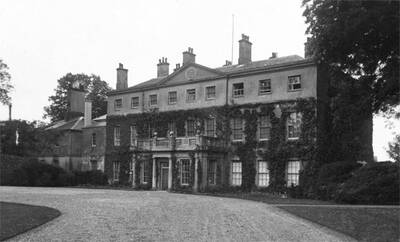
Billing Hall, Billing, Northamptonshire, England. Telah dirobohkan pada tahun 1956: “The estate expanded over the next century until it was sold in 1931 (see SC 549 and Map 4207) and with the proceeds the family purchased Elsham Hall, Lincolnshire, from Kings College, Cambridge. It was envisaged that Billing Hall would be used as a home for indigent musicians (in memory of Gervase Elwes) but the scheme failed and after further unsuccessful ownership it was sadly demolished in 1956.” (The National Archives UK: |"ELWES (GREAT BILLING)". Gambar: Matthew Beckett @ Lost Heritage: |"Billing Hall").
1895-12-24: Permohonan Tanah di Kepong
Pada 24/12/1895, M.S. Parry bersama rakan-rakan kongsi beliau (Allen, Hicks, Skinner) pernah memohon beberapa bidang tanah seluas 500 ekar setiap seorang di Kepong (PEJABAT SETIAUSAHA KERAJAAN NEGERI SELANGOR, 24/12/1895: |"APPLICATIONS FOR LAND, 7? AND 10TH MILE ULU SELANGOR EXTENSION (MESSR. ALLEN, HICKS SKINNER & PARRY 500 ACRES EACH) 2. SALE OF LAND AT BATU (ON RAILWAYLINE) BY AUCTION"). Namun mereka membatalkannya sebulan kemudian pada 31/01/1896, sebelum memohon tanah-tanah di Rekoh, yang kemudiannya menjadi West Country dan Belmont Estates (PEJABAT SETIAUSAHA KERAJAAN NEGERI SELANGOR, 31/01/1896: |"LAND IN KEPONG - WITHDRAWAL OF ALL APPLICATIONS FOR (MESSR. HICKS, ALLEN, PARRY AND SKINNER)").
1896-03: Pembukaan Belmont Estate
Pada bulan Februari 1896, pemangku pegawai daerah Ulu Langat telah menerima beberapa permohonan pembukaan ladang kopi di sekitar Jalan Reko. Beliau turut mengesyorkan agar pihak kerajaan mewartakan keseluruhan kawasan hutan terbiar di situ sebagai tanah rizab perladangan: “The Acting D.O., Ulu Langat, writes: 'Several applications have been sent in for waste land on the right bank of the Langat River off the Rekoh Road. There seems little doubt that the land applied for together with a great extent of waste land south of the proposed Klang-Kajang Road, forms part of an all but continuous alluvial plain which stretches down to join the Klang planting reserve on the side of the Langat Road; and if this should prove to be the case, it is greatly to be hoped that the Government will see its way to reserving the whole plain for coffee planters, as it is at present entirely waste, contains no mining land, and is the only portion of the district which is in the smallest degree suitable for a planting reserve.'” (The Singapore Free Press and Mercantile Advertiser (Weekly), 25 February 1896, Page 14: |"SELANGOR NOTES").
Pada bulan Mac 1896, penama-penama bagi permohonan ladang-ladang tersebut telah disiarkan, iaitu F. Baptist (F.B.) Hicks, E. B. Skinner, Arthur Acland (A.A.) Allen, dan E.J. Allen (West Country Estate), G.F.S. dan Methold Sidney (M. S.) Parry (Belmont Estate), dan Kindersley (Reko Hill dan Sungai Reko Estate, diikuti beberapa lagi ladang lain): “Regarding planting in Ulu Langat, Selangor, Mr. Skeat writes in his report: 'The outlook as regards the development of the district by European planters is, on the other hand, most encouraging, and it is greatly to be hoped that the present year will see coffee planting started in earnest on a large scale. Four applications for 320 acres each were received from Messrs. F.B. Hicks, E.B. Skinner, A.A. Allen, and E.J Allen, and two more applications, also for 320 acres each, from Messrs. G.F.S. and M. Sidney Parry, whilst a previous application from Messrs. Kindersley for 320 acres on the Rekoh Road has been granted. The land embraced by the first six applications is a tract upon the right geographical bank of the Langat River, in the neighbourhood of Merbau Tumbang and Bukit Tempurong. It forms the upper end of the broad alluvial flats which stretch, roughly speaking, from the Langat River at Rekoh to the Langat Road at Klang, and merge into the coffee reserve in Klang District. When it is once thoroughly drained and roaded, it should include an abundance of excellent coffee land from which selections cloud be made by intending planters, and it would therefore prove no small advantage if a continuous coffee reserve, running through the two districts, could be proclaimed by the Government.'” (The Singapore Free Press and Mercantile Advertiser (Weekly), 17 March 1896, Page 13: |"COFFEE PLANTING IN THE LANGAT DISTRICT").
LATAR PERISTIWA: Belmont Estate.
1897-03-26: Bangunan Balai Polis Reko
Bangunan balai polis Reko tidak lagi digunakan oleh pihak polis, lalu bakal disewakan kepada M. Sydney Parry, salah seorang pemilik Belmont Estate: “I have the honour to report receipt of an application from Mr M. S. Parry, Manager of the Belmont Estate near Reko, enquiring as to the terms on which the Government may be prepared to sell in lease the Police Station and Compound at Reko. 2. The station in question has recently been abandoned by the Police and is at present occupied by a caretaker. 3. I do not think it will be advisable to sell the land outright but see no objection to leasing it to Mr. Parry for -say- two years, at a nominal rent of $1- per annum to include the use of the house. 4. Should this suggestion be approved the applicant is prepared to put the building into good repair, a course which necessitates a certain fixity of tenure. … - Acting District Officer, Ulu Langat.”
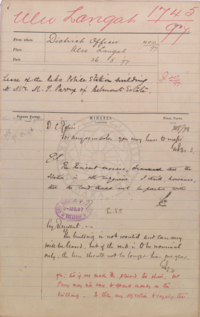
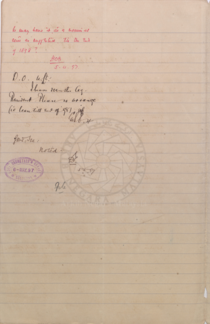
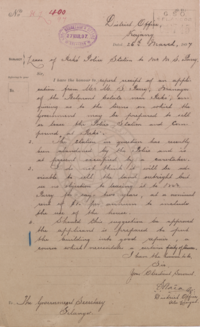
(Sumber: PEJABAT SETIAUSAHA KERAJAAN NEGERI SELANGOR, 26/03/1897 @ Arkib Negara Malaysia: |"LEASE OF THE REKO POLICE STATION BUILDING TO MR. M.S. PARRY OF BELMONT ESTATE").
1906-05-19: The Kuala Lumpur Rubber Company Ltd
Pada 19 Mei 1906, M.S. Parry bersama Everard Feilding, Edouard Bunge, Alfred Grisar, John Gurdon, dan Edward Henry Tootal, menubuhkan The Kuala Lumpur Rubber Company Ltd., yang mengusahakan ladang-ladang getah di sekitar Kuala Lumpur dan Lembah Kelang, termasuk “Bungstar Estate” (gabungan “Bunge” dan “Grisar”, kini “Bangsar”). Syarikat ini kemudiannya telah mengambil alih beberapa syarikat lain, antaranya Kepong Rubber Estates (sekitar 1959-1961) dan Taiko Plantations (1983), dan kini dikenali sebagai Kuala Lumpur Kepong Berhad.

“Incorporated on 19 May 1906, KLK will be 100 years old on 19 May 2006. Registered as “The Kuala Lumpur Rubber Co. Ltd. (“KLR”), with its office at 9 Arundel Street, London, it set out to plant rubber around Kuala Lumpur –
then under the British administration – to capitalise on the booming rubber price brought about by the introduction of the modern motor-car and pneumatic rubber tyres as replacement for horse-drawn carriages in the US. Not much is known about the early founders of KLR, except that the first Board comprised the following:
Hon. Everard Feilding (Chairman)
Edward Henry Tootal (Vice-Chairman)
Edward Bunge
Alfred Grisar
Methold Sidney Parry
It seemed that Mr Feilding was a member of the royal family and also Secretary of the Society of Psychic Research, although any linkage with rubber planting if any, must be coincidental. … With a paid-up capital of £180,000 KLR managed to acquire 5 estates, namely; Kent, Uganda, Wardieburn, Mount and Klang Gates, totalling 640 ha and for a princely sum of £160,000. Although certain of the estates were named after familiar places back in the homeland, there was no doubt all these purchases were located in what is now known as the Klang Valley. With success achieved, newer estates were added on, for example, Kuang and Rawang Estates in 1912.”
(Sumber: Kuala Lumpur Kepong Berhad, 2005: |"Kuala Lumpur Kepong Berhad Annual Report 2005").
“By 1906, British capitalists were seizing the opportunity to make fortunes by investing in Malayan rubber plantations. The London-based Kuala Lumpur Rubber Company was incorporated on May 19, 1906, and began planting rubber trees around Kuala Lumpur. Among its first board members were Edouard Bunge and Alfred Grisar. The estate they owned was Bungsar Estate. The nomenclature was derived from a contraction of their joint names and was adopted by Bungsar Road (now Jalan Bangsar) when it was built in 1912. …. In 1982, Jalan Parry was posthumously renamed in the memory of P. Ramlee, who is considered by many as Malaysia’s greatest singer, producer, director and silver screen idol.” (Alan Teh Leam Seng @ New Straits Times, October 21, 2019: |"How KL's streets got their names").
“The board of directors has 4 to 8 members; currently, it is composed by MM. Everard Feilding, President; Edouard Bunge, Alfred Grisar, John Gurdon, esq., Mr. Sydney Parry and Edward Henry Tootal.” (Alain LÉGER @ Les entreprises coloniales françaises: Comptoirs français de l'Inde INDOCHINE: Indes néelandaises, Malaisie, Siam, 2020: |"Kuala Lumpur Rubber Company Ltd (The)").
1909-1920: Bujong Rubber Estate
M.S. Parry dilantik sebagai pengerusi lembaga pengarah Bujong Rubber Estate, Sungai Buloh mulai sekitar 1909 sehingga ia diambil alih oleh Kepong Malay Rubber Estates pada tahun 1920 (Straits Echo, 8 July 1911, Page 7: |"Bujong Rubber Estate.", The Straits Times, 29 June 1920, Page 12: |"BUJONG RUBBER ESTATE.").
1910-1911: Buku The ABC to Rubber Planting Companies in Malaya
Pada tahun 1910, M.S. Parry bersama E.M. Muraour telah menerbitkan buku berjudul The ABC to Rubber Planting Companies in Malaya, memuatkan perincian mengenai 140 buah syarikat-syarikat getah di Tanah Melayu, untuk panduan para pemodal agar tidak terlalu bergantung kepada maklumat spekulator. Edisi kedua buku ini diterbitkan pada tahun 1911, mengandungi 256 buah syarikat, termasuk syarikat-syarikat di Sumatera dan Borneo.

“Parry, Methold Sidney, & E.M. Muraour. The ABC to rubber planting companies in Malaya. Comprising the following particulars: issued capital, planted acreage, &c., together with estimates for all companies of possible production, profits, and dividends for the next seven years. , London, Fredc. C. Mathieson & Sons. First edition. Chancery 8vo (21 x 8 cm), pp.xv, 140. Bound in original cloth-backed printed boards. Boards soiled and worn, but sound. One short marginal tear to final text leaf; contents otherwise in very good condition [14044] SOLD.”
Perihal buku ini: “The first appearance of this investor’s guide to rubber plantations, with detailed figures and company information for 140 companies active in Malaya. Parry and Muraour outline their methodology in the introduction. They chose conservative estimates of production and profit, relative to the market prices of 1909 and 1910, as they felt the industry was attracting ill-advised speculation, and wished this ABC to serve as a comparative tool for investors. Ceylon and Java were excluded from consideration as too removed from the Malaya plantations to provide a fair comparison; Sumatra and Borneo were to follow in separate editions. Each company’s offices, contact information, and management are listed, together with the date of establishment and location of their land. All but two of the listed companies were founded after 1900, with a majority founded in 1909, speaking to the massive rubber boom underway, and the large audience for this slim book. Production, profit, and dividend forecasts are provided for seven years, to allow for increases in production by recently established plantations. Additional crops, such as tapioca and coconuts, are listed, but not factored into the forecasts. A second edition, expanded to 256 companies, including those newly floated and others in Borneo and Sumatra, was published in 1911. Methold Sidney Parry was Director of the Kuala Lumpur Rubber Company; he notes in the preface that he used only publicly available information to prepare this guide, to avoid any suggestion of insider activity, and maintain its usefulness as a fair comparative tool. [We locate copies at the British Library, Cambridge, Institute of Social History (Amsterdam), and Oxford.”
(Sumber: John Randall @ Books of Asia, 22/1/2021: |"Orientalia 7: Southeast Asia", m.s. 26/32).
1916: Aktivisme dan Perkahwinan
Sekitar tahun 1916, M.S. Parry menyokong perjuangan Roger Casement, seorang aktivis hak asasi manusia di Congo dan Peru, kemudiannya pejuang pembebasan Ireland. Laporan Roger Casement pada awal 1900-an adalah antara pencetus gerakan memansuhkan sistem perhambaan pekerja berhutang: “International support for unfree labour in any form dropped off markedly, however, in the early twentieth century after the founding of the Congo Reform Association in 1904. The publications of the British journalist E.D. Morel and the Irish diplomat Roger Casement exposed the enslavement, torture, and mutilation of rubber workers in the Belgian Congo, which fuelled an international campaign in defence of the human rights of colonial subjects. Since the British government commissioned, published, and defendedCasement’s report, it was in a weak position to protect its own practice of indentured labour, which had come under attack, too. During the first decade of the twentieth century, Indian nationalists had mounted fierce assaults on indenture in South Asia as well as in South Africa, while local opposition to the practice grew in Natal, Mauritius, Assam, and Trinidad. Workers’ groups took to the streets, while colonial officials felt free to point out abuses in the system. The Anti-Slavery and Aborigines’ Protection Society added its voice to an international anti-indenture campaign, which helped to abolish the practice in British Malaya in 1910 and in remaining British colonies by 1920.” (Lynn Hollen Lees, 2017: |"Planting Empire, Cultivating Subjects: British Malaya, 1786–1941, pp. 171 - 217).
Ketika Casement ditangkap dan diadili pada tahun 1916, beliau turut melibatkan diri bersama para peguambela dan melawatnya di penjara. Setelah Casement dihukum mati, M.S. Parry mengutus surat terakhir kepada Casement, dan berjanji untuk menjaga keluarganya. Beliau juga turut menerbitkan makalah yang menceritakan kisah hidup Casement. Pada tahun 1934, beliau memulakan kerjasama dengan Bulmer Hobson untuk menerbitkannya dalam bentuk filem (National Library of Ireland: |"Parry, M. S. (Methold Sidney), 1863-1937").
Sementara itu, sepupu Roger Casement, Gertrude Bannister, adalah antara penyokong rapat Casement. Mereka dibesarkan bersama, maka hubungan di antara keduanya rapat sejak kecil lagi. Mereka saling berutus surat sepanjang kegiatan-kegiatan aktivisme beliau itu: “Gertrude and Edward were two of the children of Grace Ann and Edward Bannister of Liverpool. Before her marriage, Grace Ann was a Jephson and her sister was the mother of Roger Casement. Roger Casement was a man who believed in freedom and the Irish State. He was involved in the 1916 Easter Rising to the extent that he had gone to Germany to obtain military aid for the cause. The British arrested him on charges of High Treason. Eventually he was tried, sentenced then hanged on 3 August 1916. One of his greatest supporters was his cousin Gertrude. She was also the sole beneficiary of his will.” (Gary Cook, Sep 1, 2019: |"Moving to America in the 1920's").
Koleksi surat-surat mereka masih tersimpan di dalam arkib negara Ireland sehingga kini (National Library of Ireland: |"Roger Casement Papers, 1889-1945").
Pada bulan Mei 1916, Gertrude melawat Roger Casement ketika beliau di dalam tahanan kerajaan England akibat dari aktiviti subversif beliau itu (The National Archives UK: |"TREASON: Sir Roger Casement: Gertrude Bannister, Casement's cousin, requests permission to visit Casement").

Lukisan bertajuk “High Treason”, oleh Sir John Lavery, menggambarkan keadaan di Royal Courts of Justice, England, di mana Roger Casement dijatuhkan hukuman mati atas kegiatan beliau itu. Di dalam lukisan ini, Gertrude Bannister sedang duduk di kalangan barisan peguambela. Peguambela Gavan Duffy sedang meneliti dokumen bersama rakan peguam dari Amerika Syarikat, Michael Francis Doyle, diikuti Margaret (isteri Gavan Duffy) yang sedang mencatat, Gertrude, dan di hujung sekali sahabatnya, Ada McNeill: “The verdict was ‘High Treason’ and that was the title given to the painting depicting one of the most famous trials in British and Irish legal history. In Sir John Lavery’s painting we look directly towards the accused, Sir Roger Casement. His Counsel, Serjeant Sullivan pleads the case for the defence. The main prosecution counsel, the Attorney General Sir Frederick E. Smith, unionist and one of the founders with Edward Carson of the Ulster Volunteers, sits ignoring a prompting from his junior counsel. In the solicitors’ row, Casement’s representative, Gavan Duffy, is seen studying a document with the American lawyer Michael Francis Doyle by his side and three women: Duffy’s wife Margaret, taking notes, Casement’s cousin Gertrude Bannister (Mrs. Parry) and his friend Ada McNeill. In the public gallery, Eva Gore Booth, sister of Countess Markievicz, then imprisoned following the commutation of her death sentence, is shown. On the bench are five judges led by Mr. Justice Darling who is said to have arranged for Lavery to do the painting. (Lavery had previously painted a portrait of Darling wearing the black cap used for pronouncing a death sentence).” (Ed Mulhall, 9 Aug 2016: |"Roger Casement: ‘High Treason’ & the Politics of Hanging". Gambar: Milton John, 12/02/2019: Notes on a lecture – “High Treason” The background to the Casement painting by John Lavery).
Sekitar akhir tahun 1916, M.S. Parry dan Gertrude Bannister telah melangsungkan perkahwinan mereka (National Library of Ireland, 30 September 1916: "Letter from Fr. Murnane to Sidney Parry informing him it would be a joy for him if he and Gertrude Bannister were to be married in his church, that it is the most Irish church in London and also informing him of the necessary arrangements for the wedding,").
Setelah berkahwin, Gertrude dikenali sebagai Gertrude Agnes Parry. Mereka kemudiannya berpindah ke Oxmead, Ewhurst, England. Di sana mereka dikatakan telah memberi perlindungan kepada beberapa orang pelarian perang dunia pertama dari Belgium: “Mrs Parry was his sister. Her married name was Gertrude Agnes Parry. She’d married a chap with the unlikely name of Methold Sidney Parry in around 1916 and they moved into Oxmead sometime after a man called Truman Press left. .. Speaking of his sister; Gertrude, and husband Methold, eventually moved to Cushendall in County Antrim, Northern Ireland where they both died though about 20 years apart. During his life, Methold was a bit of an authority on Malaysian rubber and had, in fact, written a book on the ABC of Rubber Planting in Malaya, an obvious page turner of great pace. He was also, for a while, a director of the Kuala Lumpur Rubber Company from its incorporation in 1906. He really knew his rubber. Unfortunately I’ve not found a photo of Methold either. And as for Oxmead in Ewhurst, where Gertrude and Methold lived, apart from being their home, they also offered to house Belgian refugees at the beginning of the Great War, taking six early on. It has been through a few name changes but is now called Campions.” (Gary Cook, Sep 1, 2019: |"Moving to America in the 1920's").
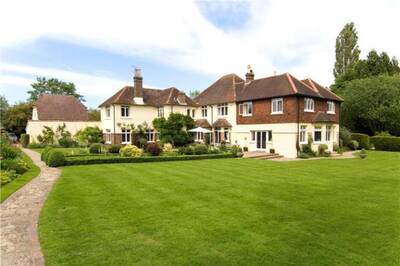
Rumah pasangan Mr dan Mrs. Parry ketika di Oxmead, Ewhurst, Surrey, England, kini: “And as for Oxmead, Ewhurst, where Gertrude and Methold lived, apart from being their home, they also offered to house Belgian refugees at the beginning of the Great War, taking six early on. It is now called Campions and, I reckon, is a pretty impressive country pile. And of the house I found a photo!” (Gary Cook, 27 August 2019: |"Living in America").
1918: Penyunting Buku The Free Seas in War
Pada tahun 1918, sebuah buku suntingan M.S. Parry telah diterbitkan: |"The Free Seas in War: A TALK TO THE MEN AND WOMEN OF GREAT BRITAIN ON THE FREEDOM OF THE SEAS. by SIR FRANCIS PIGGOTT, Together with Extracts from The Writings and Speeches of DAVID URQUHART, Compiled and Commented on BY M. SIDNEY PARRY, B.A., Oxon.".
1921: Buku The Avenue to Peace
Pada tahun 1921, M.S. Parry telah menerbitkan buku berkaitan pembebasan Ireland, berjudul “The avenue to peace in 1921 : Ireland's claim to independence : how England met this claim in 1782, a resumé of Irish history from 1775-1800 compiled from Lecky's History of Ireland in the 18th century” (WorldCat).
1923-08-13 - 1929-08-19: Wartawan C.P. Scott
Antara 13/8/1923 hingga 19/8/1929, terdapat 7 rekod perhubungan di antara M.S. Parry dengan Charles Prestwich (C.P.) Scott, wartawan, editor, dan pemilik akhbar Manchester Guardian (kini The Guardian). Antara topik perbincangan ialah Pencerobohan Ruhr, Jerman, oleh Perancis (1923-1925), Stevenson Rubber Restriction Scheme (1922-1928), dan isu berkaitan Reparations (1929): “Correspondence with Methold Sidney Parry, (1863-1937), rubber planter, relating to the provision by Parry of an [unknown] pamphlet on the occupation of the Ruhr by France, and discussion of the subject. Also included is an offer of an article by Parry on the [Stevenson] rubber restriction scheme for publication in the Manchester Guardian, which is declined, owing to its length, with a request for the provision of a shorter letter to the editor on the subject. There is also discussion of concerns expressed by Parry as to negotiations of the distribution of reparations, and of Britain's representation by [Philip Snowden, politician].” (Jisc Archives Hub: |"Correspondence with M. Sidney Parry").
1928: Di Antrim, Ireland
Pada tahun 1928, terdapat rekod kegiatan Mrs. Gertrude Parry di dalam temasya budaya Gaelic “feis” di daerah Antrim, Ireland Utara. Kemungkinan mereka telah pun berpindah ke sana ketika itu: “Some of the original Feis committee remained and succeeded in re-establishing the Feis in 1928. They included Margaret Dobbs, Ada McNeill, John Clarke and a local schoolteacher, Hugh Flatley. They were joined by others including Andy Dooey, Padraic and Sibeal Mac Cormaic and Mrs Sydney Parry (nee Gertrude Bannister), a cousin of Roger Casement and the last person to visit him before his execution.” (Eamon Phoenix @ Ulster Historical Foundation, 2005: "Feis Na NGleann: A Century of Gaelic Culture in the Antrim Glens", m.s.4).
1932-1934: Pengerusi South Perak Rubber Syndicate
Sekitar tahun 1932 hingga 1934, beliau kembali aktif dalam pengurusan perladangan getah. Sekitar 2 tahun ini, beliau telah mempengerusikan mesyuarat tahunan South Perak Rubber Syndicate (The Straits Times, 21 April 1932, Page 9: |"CONTROL OF OUTPUT.", Malaya Tribune, 17 December 1934, Page 3: |"SOUTH PERAK RUBBER").
1937-08-17: Meninggal Dunia
M.S. Parry meninggal dunia pada 17 Ogos 1937 di Cushendun, Antrim, Ireland Utara: “Mr. Parry died suddenly on the 17th inst. at his residence at Cushendun, Co. Antrim, at the age of seventy-three.” (Catholic Herald, 27th August 1937: |"Mr. M. Sidney Parry").
Kematian beliau turut diumumkan di akhbar tempatan beberapa hari kemudian: “The death is announced today of Mr. Methold Sidney Parry, chairman or director of Batu Rata, Beaufort, Bradwall, Dennistown, Kamna, Kuala Lumpur, Lok Kawi, Sedgeley, and South Perak, rubber companies. Mr. Parry was one of the old pioneer planters in Malaya and arrived in this country about 1896. He worked on estates in the Kuala Lumpur and Kajang districts an retired just after the Great War. He was educate at Cheltenham and University College, Oxford.” (The Singapore Free Press and Mercantile Advertiser, 21 August 1937, Page 9: |"Pioneer Planter Dies In England").
Berikut adalah rekod mengenai rumah terakhir beliau, yang mula didiami setahun sebelumnya (1936): “In 1911 the Census of Ireland described Rockport Lodge as a 1st class dwelling that consisted of 19 rooms and possessed extensive outbuildings including a stable, coach house, cow house, a dairy, store and laundry. Louisa Higginson continued to hold the house as a summer residence until her death in 1935 (PRONI Wills). Rockport Lodge passed to Sidney Parry, a rubber planter of London, in 1936 and under the First General Revaluation of Property in Northern Ireland (1936-57) the value of the property was increased to £57. The Sidney family vacated the site in c. 1943 when Rockport passed to Robert Walshe, a local cinema owner.” (Department for Communities UK, 2015: |"Historic Building Details: Rockport Lodge").




Gambar-gambar kawasan kediaman terakhir M.S. Parry, kini: “Situated in Cushendun in the Antrim County region and Cushendun Caves reachable within 1.9 km…” (Booking.com, 2019: |"Rockport Lodge").
Peninggalan
Jalan Parry (kini Jalan P. Ramlee)
Salah satu jalan di Kuala Lumpur telah dinamakan sempena beliau: Parry Road / Jalan Parry, kini dikenali sebagai Jalan P. Ramlee.

Jalan Parry / Jalan P. Ramlee, kini: “Jalan P. Ramlee was originally called Parry Road. It was named after planter Methold Sidney Parry, who was the director of a number of rubber plantation in late 19th century Kuala Lumpur.” (Timothy Tye: "Jalan P. Ramlee, Kuala Lumpur").
Ex-Libris
M.S. Parry pernah memperolehi khidmat Thomas Shepard bagi merekacipta |ex-libris (penanda pemilikan buku) peribadi, yang turut memuatkan jata keluarga beliau.

“Thomas Shepard (1860-20.2.1937) zeichnete dieses fast quadratische, undatierte Exlibris für Methold Sidney Parry (23.9.1863-1937), verheiratet mit Gertrude Bannister (-1950). Die Initialen des Künstlers befinden sich in den beiden unteren Ecken über der Eignernennung. Zur Erreichung der Quadratform wurde das Oberwappen abgenommen und heraldisch rechts neben den Schild gestellt, der dem Schweif des Löwen wiederum schwungvoll durch Linksneigung ausweicht und in das Rahmenornament hineinragt. Die ansonsten schlichte Helmdecke ist in schwungvollem Bogen unter dem Schild bis an den Rand gezogen und endet mit einem dicken Knoten.
Das Wappen Parry zeigt in Silber einen blauen, mit drei goldenen Getreidegarben belegten Sparren, begleitet von drei blauen Löwen (engl.: Argent on a chevron between three lions rampant Azure, as many garbs Or). Auf dem blau-silbern bewulsteten Helm mit blau-silbernen Decken ein wachsender blauer Löwe, auf dem Kopf eine goldene Getreidegarbe (engl.: mantling Azure and Argent, crest: on a wreath of the colours a demi-lion rampant Azure, upon the head a garb Or). Die Devise lautet: E VIRTUTE COPIA.
(Google Translate: Bookplate by Thomas Shepard: Thomas Shepard (1860-20.2.1937) drew this almost square, undated bookplate for Methold Sidney Parry (23.9.1863-1937), married to Gertrude Bannister (-1950). The artist's initials are in the two lower corners above the owner's name. To achieve the square shape, the top coat of arms was removed and heraldically placed on the right next to the shield, which in turn evades the lion's tail by leaning to the left and protrudes into the frame ornament. The otherwise simple helmet cover is drawn in a sweeping curve under the shield to the edge and ends with a thick knot.
The Parry coat of arms shows in silver a blue rafter covered with three golden grain shades, accompanied by three blue lions (Argent on a chevron between three lions rampant Azure, as many garbs Or). On the blue-silver puffed helmet with blue-silver blankets a growing blue lion, on his head a golden sheaf of grain (English: Mantling Azure and Argent, crest: on a wreath of the colors a demi-lion rampant Azure, upon the head a garb Or). The motto is: E VIRTUTE COPIA.)”
(Sumber: Bernhard Peter, 2017: |"Britische heraldische Exlibris (12)").
Pengakuan penting: Kami bukan ahli sejarah! Sila klik di sini untuk penjelasan lanjut.
